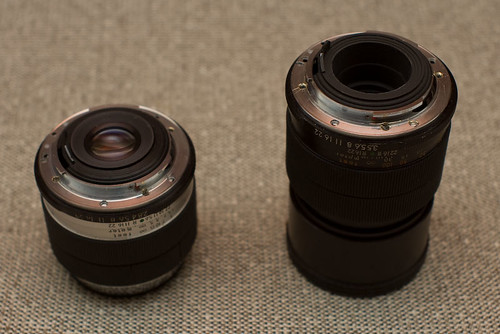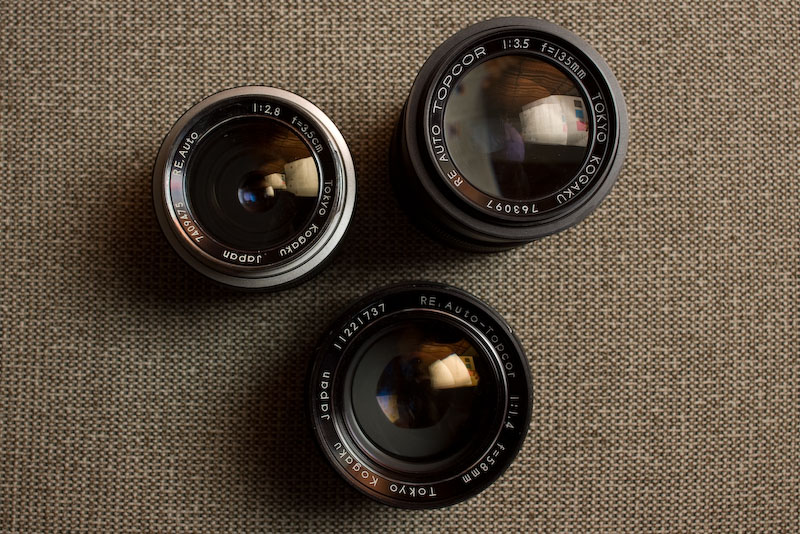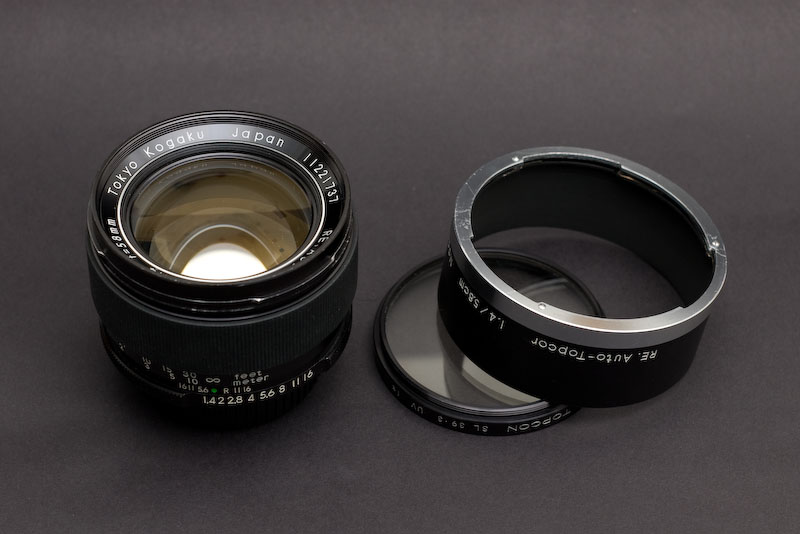The rationale:
The great thing with Pentax digital slr cameras is that you can mount basically everything on them and they still meter. The camera does not need any information about the lens mounted. That makes it easy to mount even the stranges lens on the camera by just screwing a Pentax bayonet on it.
Topcon lenses are highly sought after and there are quite some collectors (http://members.cox.net/topconcollection/index.html). That unfortunately makes them quite pricey. Their quality has always been considered high, unfortunately none of them (except for the very last generation, which was a different design) is multi-coated. I got interested in Topcon lenses when I heard that Cosina re-manufactured the Topcor 58mm/1.4 and after seeing some pictures taken with this lens. There currently is a new edition of it, the Voigtlander 58mm/1.4 Nokton (http://www.cameraquest.com/Voigt_SL2.htm). I did not get a 58mm topcor, yet since it is hard to find it cheap, but I found a reasonable priced Topcor 35mm/2.8 and a 135mm/3.5 for a the price of 3 chocolate bars- I decided to convert them to Pentax K mount.
Topcon collectors will maybe hate me for gutting and abusing these lenses, but I do not see much sense in having them sitting on a shelf and collecting dust. The conversion is completely reversible by the way.
The conversion:
Please note that this is for the Topcon RE bayonet, the Topvon UV and IR might be much more complicated.
The register distance (the distance from the lens to the film plane) of Pentax K lenses is 45.46mm, while the one for topcor RE lenses is 44.7mm (
http://www.graphics.cornell.edu/~westin/misc/mounts-by-register.html). That means if one would try to mount a topcor lens on a Pentax it would most likely not focus to infinity. That's why there is no "screw on" adapter to mount Topcon lenses on Pentax. The same should be true for Nikon, it is possible, though, to mount them on Canon (and there are adapters).
Fortunately the Topcon bayonet is quite thick, and I figured when removed and replaced by a Pentax bayonet I gain the few millimeters needed to focus to infinity.
The parts:
I got the Pentax bayonets from a A 50mm f2 and a Takumar-A 28-80mm zoom. Most of the Pentax bayonets are very similar when removed, so any should work. I would have preferred a bayonet from a non-A lens, but this is what I had. The Topcon 35mm lens is from the second generation, the 135mm is a 3rd generation.
Removing the Topcon bayonet:
The bayonet is held in place by 4 screws. Topcon glues the screws into the thread which makes them very hard to remove. I grabbed my watchmaker screwdriver with pliers, pressed it down hard with one hand while turning with the other. The 2nd generation lenses have slot head screws, this makes it even harder- I ruined the screws while removing them and had to replace them.
I removed the bayonet and any loose parts under it. This will also remove the bracketing mechanism of the aperture ring (watch the small metal ball!). Since the aperture ring is moving, I did not find a good replacement to make it working again, yet.
As you can see the aperture ring stays fixed on the lens, this makes it very easy to mount the Pentax bayonet.
Mounting the Pentax bayonet:
To mount the Pentax bayonet one has to drill 4 holes in it which match the postion of the threads on the lens. Normally I would have made a "carbon" copy of the the positions on paper and transfer them to the bayonet, but in this case I could just put the Pentax bayonet on top of the Topcon, I centered it and fixed it with scotch tape. Than I marked the positions of the holes by scratching with a drill through the holes. (see below). This has to be very exactly matched. Another thing to pay attention to is that the red dot of the Pentax bayonet marks the position of the aperture index mark. I copied the position of the index to the topcor bayonet before removing and than aligned it with the red dot.

Next I drilled the holes in the bayonet, since the screws have to be countersunk I widened the hole with a much larger drill. If this is not done carefully you might not be able to mount the lens on the camera, or you might scratch the mount of the camera (guess how I found out...).
I was lucky that both plastic collars to block stray light from the 50mm and 28-80mm nearly fit on the Topcon lenses. I had to sand them a little bit to make them wider and trim the 50mm as bit to fit it on the 35mm Topcon lens.
Finally:
I could screw the mount on the lens and mount it on my DS! Infinity works, the lens basically behaves like an M42 lens with adapter: focus with the aperture wide open, close the aperture to the desired setting, check DOF - take picture. The bracketing of the aperture is missing but it also makes one concentrate on the DOF more. One strange thing is that all EXIF files record the wide open aperture from the original Pentax lens (in spite of I removed the pin for the A setting), this is also useful since it tells me which lens I mounted.
Update, the Topcor 58mm 1.4:
I found a reasonably priced Topcon 58mm f1.4 and converted it to a Pentax mount as well. I added pictures of the lens and samples below.
Examples:
First some pictures of the lenses:



Next I drilled the holes in the bayonet, since the screws have to be countersunk I widened the hole with a much larger drill. If this is not done carefully you might not be able to mount the lens on the camera, or you might scratch the mount of the camera (guess how I found out...).
I was lucky that both plastic collars to block stray light from the 50mm and 28-80mm nearly fit on the Topcon lenses. I had to sand them a little bit to make them wider and trim the 50mm as bit to fit it on the 35mm Topcon lens.
Finally:
I could screw the mount on the lens and mount it on my DS! Infinity works, the lens basically behaves like an M42 lens with adapter: focus with the aperture wide open, close the aperture to the desired setting, check DOF - take picture. The bracketing of the aperture is missing but it also makes one concentrate on the DOF more. One strange thing is that all EXIF files record the wide open aperture from the original Pentax lens (in spite of I removed the pin for the A setting), this is also useful since it tells me which lens I mounted.
Update, the Topcor 58mm 1.4:
I found a reasonably priced Topcon 58mm f1.4 and converted it to a Pentax mount as well. I added pictures of the lens and samples below.
Examples:
First some pictures of the lenses:




The weather wasn't great for photos so far, but here are some examples from the lenses.
The RE Auto Topcor 1:2.8 f=3.5cm on my *ist DS:
It minimal focus distance is 23cm, which makes it nearly a macro lens:

 I like the flare effect of the bokeh at the just-out-of-focus areas.
I like the flare effect of the bokeh at the just-out-of-focus areas.The RE Auto Topcor 1:1.4 f=58mm on my *ist DS:
Most are close focus. I will do a comparison to the Takumars 55/1.8 and 50/1.4 and the A 50/1.7 next. Of course it also would be interesting how it compares to the Voigtlander 58mm/1.4 Nokton, but I am not sure if I will get this lens.
f 1.4

f 1.4

f 5.6

f 1.4

f5.6

f 1.4






